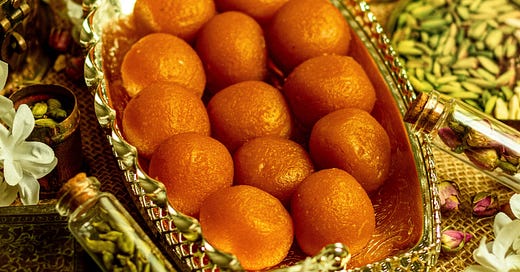Welcome to the Brown History Newsletter. If you’re enjoying this labour of love, please do consider becoming a paid subscriber. Your contribution would help pay the writers and illustrators and support this weekly publication. If you like to submit a writing piece, please send me a pitch by email at brownhistory1947@gmail.com. Check out our Shop and our Podcast. You can also follow us on Instagram and Twitter.
The Tale of Gulab Jamun by Nashwa Ansari
Gulab Jamun has been synonymous with the taste of celebrations in the minds and hearts of South Asians, the beloved dessert has held a nostalgic value that has been cemented through decades of it being served at the smallest and biggest of occasions. It is the taste of happiness and is undoubtedly one of the most popular mithai around. Mithai is an all-encompassing word for sweets in Urdu/Hindi, and sweet shops or mithai ki dukaan is where you can find a plethora of South Asian sweets and desserts, including the Gulab Jamun. Typically served warm, a bite of this dessert has the ability to engulf you in a symphony of warmth and familiarity with subtle flavour profiles of cardamom, rose, and saffron. While its origins are disputed, there are various versions of this sweet across South Asia and beyond, with variations in its shape, size, and flavour profiles. Gulab Jamun has stood the test of time and endured through centuries of culinary innovations to prevail on top of the list of the seemingly endless sweets and desserts to come out of South Asia.





